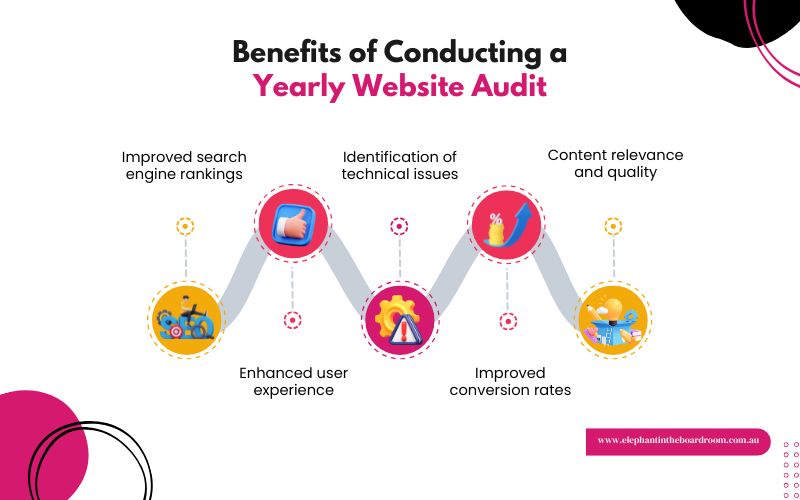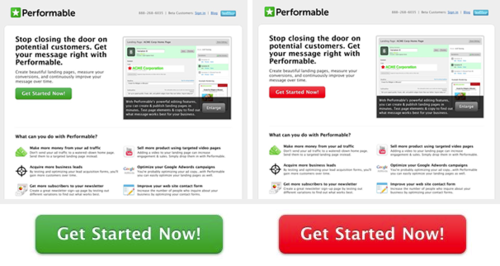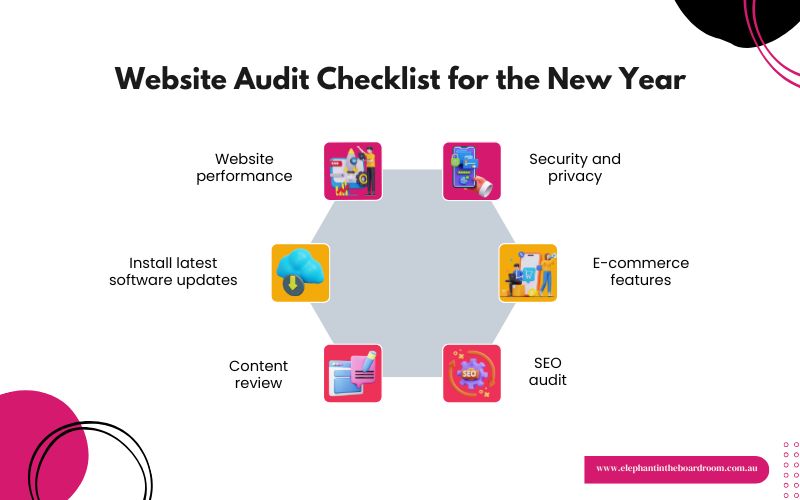
Just as a home requires regular upkeep to maintain its structural integrity, your website demands ongoing attention to remain a high-performing employee. A website audit is a comprehensive health check for your digital presence, ensuring everything is optimised—from speed and security to SEO and user experience. Your website is the cornerstone of your online strategy, and ensuring it’s both inviting and efficient is critical to driving results.
As you set your goals for the year ahead, positioning your website for success should be a top priority. Now is the perfect time to evaluate and refine your digital foundation. Explore our guide to discover essential website checks that will prepare your online presence to thrive in the coming year.
What’s Inside:
- What is a Website Audit?
- Benefits of Conducting a Yearly Website Audit
- Website Audit Checklist for the New Year
- Make the First Move for 2025: Audit Your Website Now!
What is a Website Audit?
A website audit is a comprehensive review and analysis of a website’s performance, design, and structure to evaluate its overall health and effectiveness. It helps identify strengths, weaknesses, and opportunities for improvement across various aspects of the site. A website audit gives you the information you need to make data-driven decisions, whether your goal is to increase conversions, improve user experience, or improve search engine rankings.
Benefits of Conducting a Yearly Website Audit

As a business owner or digital marketer, you are likely aware that your website is an important part of your success. But just as your business evolves, so too must your website. Conducting a yearly website audit is one of the best ways to ensure your online presence is performing at its peak.
Here’s why a yearly website audit is not just a luxury, but a necessity:
Improved Search Engine Rankings
Search engines like Google favour websites that are optimised, fast, and user-friendly. A regular audit helps you identify outdated SEO practices, broken links, or slow-loading pages that might be dragging your rankings down.
Enhanced User Experience
A yearly audit pinpoints pain points, such as confusing navigation or poor design elements, that could be driving users away. Enhancing these aspects not only keeps visitors engaged but also encourages repeat visits.
Identification of Technical Issues
Technical glitches, security vulnerabilities, or outdated software can compromise your website’s effectiveness and safety. An audit uncovers these issues early, helping you avoid downtime, data breaches, or costly repairs.
Improved Conversion Rates
An audit guarantees that your website is focused on generating results, whether that means streamlining your checkout procedure, improving calls-to-action, or optimising landing pages.
Content Relevance and Quality
Engaging users and maintaining your site's competitiveness depends on having high-quality, relevant content. A yearly review highlights content gaps, outdated information, or areas where your messaging can be refined to meet the needs of your audience better.
Website Audit Checklist for the New Year
While an audit doesn’t always uncover major issues, it is an excellent opportunity to ensure that everything is working as it should and to set yourself up for a fresh, successful year online. Even if things seem to be running smoothly, a careful review can uncover ways to improve performance, security, and user experience.
Here’s your go-to checklist to start the year off right:
Website Performance
Start by testing page load speeds using tools like Google PageSpeed Insights. Slow-loading sites drive users away and can impact your search engine rankings.
Assess mobile responsiveness to ensure your site functions seamlessly on all devices. Review hosting resources and bandwidth to confirm your website can handle increased traffic.
Optimise images, remove unnecessary plugins and enable caching to boost efficiency. A fast, responsive website creates a positive user experience and keeps visitors engaged.
SEO Audit
Search engine optimisation (SEO) evolves constantly, so updating your strategies is essential. Perform a detailed SEO audit by reviewing on-page elements such as title tags, meta descriptions, headers, and keyword usage. Identify broken links and ensure all URLs are optimised for search engines.
Evaluate your backlink profile for quality and relevance while disavowing any harmful links. Check for duplicate content and implement structured data where possible to enhance visibility. Finally, stay informed on algorithm updates to adapt your approach for better rankings.
Security and Privacy
Cybersecurity is non-negotiable. Verify that your SSL certificate is active and functioning, as it’s essential for securing user data and maintaining trust. Update all software, plugins, and CMS platforms to their latest versions to patch vulnerabilities.
Review your privacy policy to ensure compliance with data protection laws like the General Data Protection Regulation. Implement tools such as firewalls and malware scanners to keep your site secure.
Content Review
Quality content is the backbone of any successful website. Begin by auditing all existing pages for outdated or irrelevant information. Refresh key pages with updated statistics, images, and media.
Rewrite content to reflect your brand’s current goals and tone. Check for grammatical errors and ensure your messaging aligns with your audience's needs. Assess internal linking to improve navigation and boost SEO.
E-Commerce Features
For online stores, ensuring a seamless e-commerce experience is paramount. Test every step of the purchasing journey, from browsing to checkout, to identify bottlenecks. Verify payment gateways for functionality and security.
Review product descriptions and images to ensure they’re accurate and enticing. Simplify navigation to help users find what they need quickly. Consider adding features like wish lists, abandoned cart reminders, or personalised recommendations.
Install Latest Software Updates
Outdated software is a risk to both performance and security. Review your website’s CMS, plugins, themes, and integrations to confirm they’re running the latest versions. Updates often include patches for security vulnerabilities, bug fixes, and performance enhancements.
However, always back up your site before applying updates to avoid disruptions. Regularly checking for updates ensures your site operates smoothly and remains safe from threats.
Make the First Move for 2025: Audit Your Website Now!
As the new year approaches, it’s the ideal time to give your website the care and attention it deserves. A comprehensive website audit is essential for maintaining a strong, secure, and user-friendly online presence. By evaluating performance, functionality, and SEO health now, you’re not just preparing for the year ahead—you’re paving the way for lasting business success.
Don’t wait for issues to catch you off guard. Take charge of your website’s performance today and step into the new year with confidence. Need expert guidance or a detailed audit? Reach out to us, and let’s work together to ensure your website not only meets but exceeds expectations in the year ahead.

Just as a home requires regular upkeep to maintain its structural integrity, your website demands ongoing attention to remain a high-performing employee. A website audit is a comprehensive health check for your digital presence, ensuring everything is optimised—from speed and security to SEO and user experience. Your website is the cornerstone of your online strategy, and ensuring it’s both inviting and efficient is critical to driving results.
As you set your goals for the year ahead, positioning your website for success should be a top priority. Now is the perfect time to evaluate and refine your digital foundation. Explore our guide to discover essential website checks that will prepare your online presence to thrive in the coming year.
What’s Inside:
- What is a Website Audit?
- Benefits of Conducting a Yearly Website Audit
- Website Audit Checklist for the New Year
- Make the First Move for 2025: Audit Your Website Now!
What is a Website Audit?
A website audit is a comprehensive review and analysis of a website’s performance, design, and structure to evaluate its overall health and effectiveness. It helps identify strengths, weaknesses, and opportunities for improvement across various aspects of the site. A website audit gives you the information you need to make data-driven decisions, whether your goal is to increase conversions, improve user experience, or improve search engine rankings.
Benefits of Conducting a Yearly Website Audit

As a business owner or digital marketer, you are likely aware that your website is an important part of your success. But just as your business evolves, so too must your website. Conducting a yearly website audit is one of the best ways to ensure your online presence is performing at its peak.
Here’s why a yearly website audit is not just a luxury, but a necessity:
Improved Search Engine Rankings
Search engines like Google favour websites that are optimised, fast, and user-friendly. A regular audit helps you identify outdated SEO practices, broken links, or slow-loading pages that might be dragging your rankings down.
Enhanced User Experience
A yearly audit pinpoints pain points, such as confusing navigation or poor design elements, that could be driving users away. Enhancing these aspects not only keeps visitors engaged but also encourages repeat visits.
Identification of Technical Issues
Technical glitches, security vulnerabilities, or outdated software can compromise your website’s effectiveness and safety. An audit uncovers these issues early, helping you avoid downtime, data breaches, or costly repairs.
Improved Conversion Rates
An audit guarantees that your website is focused on generating results, whether that means streamlining your checkout procedure, improving calls-to-action, or optimising landing pages.
Content Relevance and Quality
Engaging users and maintaining your site's competitiveness depends on having high-quality, relevant content. A yearly review highlights content gaps, outdated information, or areas where your messaging can be refined to meet the needs of your audience better.
Website Audit Checklist for the New Year
While an audit doesn’t always uncover major issues, it is an excellent opportunity to ensure that everything is working as it should and to set yourself up for a fresh, successful year online. Even if things seem to be running smoothly, a careful review can uncover ways to improve performance, security, and user experience.
Here’s your go-to checklist to start the year off right:
Website Performance
Start by testing page load speeds using tools like Google PageSpeed Insights. Slow-loading sites drive users away and can impact your search engine rankings.
Assess mobile responsiveness to ensure your site functions seamlessly on all devices. Review hosting resources and bandwidth to confirm your website can handle increased traffic.
Optimise images, remove unnecessary plugins and enable caching to boost efficiency. A fast, responsive website creates a positive user experience and keeps visitors engaged.
SEO Audit
Search engine optimisation (SEO) evolves constantly, so updating your strategies is essential. Perform a detailed SEO audit by reviewing on-page elements such as title tags, meta descriptions, headers, and keyword usage. Identify broken links and ensure all URLs are optimised for search engines.
Evaluate your backlink profile for quality and relevance while disavowing any harmful links. Check for duplicate content and implement structured data where possible to enhance visibility. Finally, stay informed on algorithm updates to adapt your approach for better rankings.
Security and Privacy
Cybersecurity is non-negotiable. Verify that your SSL certificate is active and functioning, as it’s essential for securing user data and maintaining trust. Update all software, plugins, and CMS platforms to their latest versions to patch vulnerabilities.
Review your privacy policy to ensure compliance with data protection laws like the General Data Protection Regulation. Implement tools such as firewalls and malware scanners to keep your site secure.
Content Review
Quality content is the backbone of any successful website. Begin by auditing all existing pages for outdated or irrelevant information. Refresh key pages with updated statistics, images, and media.
Rewrite content to reflect your brand’s current goals and tone. Check for grammatical errors and ensure your messaging aligns with your audience's needs. Assess internal linking to improve navigation and boost SEO.
E-Commerce Features
For online stores, ensuring a seamless e-commerce experience is paramount. Test every step of the purchasing journey, from browsing to checkout, to identify bottlenecks. Verify payment gateways for functionality and security.
Review product descriptions and images to ensure they’re accurate and enticing. Simplify navigation to help users find what they need quickly. Consider adding features like wish lists, abandoned cart reminders, or personalised recommendations.
Install Latest Software Updates
Outdated software is a risk to both performance and security. Review your website’s CMS, plugins, themes, and integrations to confirm they’re running the latest versions. Updates often include patches for security vulnerabilities, bug fixes, and performance enhancements.
However, always back up your site before applying updates to avoid disruptions. Regularly checking for updates ensures your site operates smoothly and remains safe from threats.
Make the First Move for 2025: Audit Your Website Now!
As the new year approaches, it’s the ideal time to give your website the care and attention it deserves. A comprehensive website audit is essential for maintaining a strong, secure, and user-friendly online presence. By evaluating performance, functionality, and SEO health now, you’re not just preparing for the year ahead—you’re paving the way for lasting business success.
Don’t wait for issues to catch you off guard. Take charge of your website’s performance today and step into the new year with confidence. Need expert guidance or a detailed audit? Reach out to us, and let’s work together to ensure your website not only meets but exceeds expectations in the year ahead.

Just as a home requires regular upkeep to maintain its structural integrity, your website demands ongoing attention to remain a high-performing employee. A website audit is a comprehensive health check for your digital presence, ensuring everything is optimised—from speed and security to SEO and user experience. Your website is the cornerstone of your online strategy, and ensuring it’s both inviting and efficient is critical to driving results.
As you set your goals for the year ahead, positioning your website for success should be a top priority. Now is the perfect time to evaluate and refine your digital foundation. Explore our guide to discover essential website checks that will prepare your online presence to thrive in the coming year.
What’s Inside:
- What is a Website Audit?
- Benefits of Conducting a Yearly Website Audit
- Website Audit Checklist for the New Year
- Make the First Move for 2025: Audit Your Website Now!
What is a Website Audit?
A website audit is a comprehensive review and analysis of a website’s performance, design, and structure to evaluate its overall health and effectiveness. It helps identify strengths, weaknesses, and opportunities for improvement across various aspects of the site. A website audit gives you the information you need to make data-driven decisions, whether your goal is to increase conversions, improve user experience, or improve search engine rankings.
Benefits of Conducting a Yearly Website Audit

As a business owner or digital marketer, you are likely aware that your website is an important part of your success. But just as your business evolves, so too must your website. Conducting a yearly website audit is one of the best ways to ensure your online presence is performing at its peak.
Here’s why a yearly website audit is not just a luxury, but a necessity:
Improved Search Engine Rankings
Search engines like Google favour websites that are optimised, fast, and user-friendly. A regular audit helps you identify outdated SEO practices, broken links, or slow-loading pages that might be dragging your rankings down.
Enhanced User Experience
A yearly audit pinpoints pain points, such as confusing navigation or poor design elements, that could be driving users away. Enhancing these aspects not only keeps visitors engaged but also encourages repeat visits.
Identification of Technical Issues
Technical glitches, security vulnerabilities, or outdated software can compromise your website’s effectiveness and safety. An audit uncovers these issues early, helping you avoid downtime, data breaches, or costly repairs.
Improved Conversion Rates
An audit guarantees that your website is focused on generating results, whether that means streamlining your checkout procedure, improving calls-to-action, or optimising landing pages.
Content Relevance and Quality
Engaging users and maintaining your site's competitiveness depends on having high-quality, relevant content. A yearly review highlights content gaps, outdated information, or areas where your messaging can be refined to meet the needs of your audience better.
Website Audit Checklist for the New Year
While an audit doesn’t always uncover major issues, it is an excellent opportunity to ensure that everything is working as it should and to set yourself up for a fresh, successful year online. Even if things seem to be running smoothly, a careful review can uncover ways to improve performance, security, and user experience.
Here’s your go-to checklist to start the year off right:
Website Performance
Start by testing page load speeds using tools like Google PageSpeed Insights. Slow-loading sites drive users away and can impact your search engine rankings.
Assess mobile responsiveness to ensure your site functions seamlessly on all devices. Review hosting resources and bandwidth to confirm your website can handle increased traffic.
Optimise images, remove unnecessary plugins and enable caching to boost efficiency. A fast, responsive website creates a positive user experience and keeps visitors engaged.
SEO Audit
Search engine optimisation (SEO) evolves constantly, so updating your strategies is essential. Perform a detailed SEO audit by reviewing on-page elements such as title tags, meta descriptions, headers, and keyword usage. Identify broken links and ensure all URLs are optimised for search engines.
Evaluate your backlink profile for quality and relevance while disavowing any harmful links. Check for duplicate content and implement structured data where possible to enhance visibility. Finally, stay informed on algorithm updates to adapt your approach for better rankings.
Security and Privacy
Cybersecurity is non-negotiable. Verify that your SSL certificate is active and functioning, as it’s essential for securing user data and maintaining trust. Update all software, plugins, and CMS platforms to their latest versions to patch vulnerabilities.
Review your privacy policy to ensure compliance with data protection laws like the General Data Protection Regulation. Implement tools such as firewalls and malware scanners to keep your site secure.
Content Review
Quality content is the backbone of any successful website. Begin by auditing all existing pages for outdated or irrelevant information. Refresh key pages with updated statistics, images, and media.
Rewrite content to reflect your brand’s current goals and tone. Check for grammatical errors and ensure your messaging aligns with your audience's needs. Assess internal linking to improve navigation and boost SEO.
E-Commerce Features
For online stores, ensuring a seamless e-commerce experience is paramount. Test every step of the purchasing journey, from browsing to checkout, to identify bottlenecks. Verify payment gateways for functionality and security.
Review product descriptions and images to ensure they’re accurate and enticing. Simplify navigation to help users find what they need quickly. Consider adding features like wish lists, abandoned cart reminders, or personalised recommendations.
Install Latest Software Updates
Outdated software is a risk to both performance and security. Review your website’s CMS, plugins, themes, and integrations to confirm they’re running the latest versions. Updates often include patches for security vulnerabilities, bug fixes, and performance enhancements.
However, always back up your site before applying updates to avoid disruptions. Regularly checking for updates ensures your site operates smoothly and remains safe from threats.
Make the First Move for 2025: Audit Your Website Now!
As the new year approaches, it’s the ideal time to give your website the care and attention it deserves. A comprehensive website audit is essential for maintaining a strong, secure, and user-friendly online presence. By evaluating performance, functionality, and SEO health now, you’re not just preparing for the year ahead—you’re paving the way for lasting business success.
Don’t wait for issues to catch you off guard. Take charge of your website’s performance today and step into the new year with confidence. Need expert guidance or a detailed audit? Reach out to us, and let’s work together to ensure your website not only meets but exceeds expectations in the year ahead.

Just as a home requires regular upkeep to maintain its structural integrity, your website demands ongoing attention to remain a high-performing employee. A website audit is a comprehensive health check for your digital presence, ensuring everything is optimised—from speed and security to SEO and user experience. Your website is the cornerstone of your online strategy, and ensuring it’s both inviting and efficient is critical to driving results.
As you set your goals for the year ahead, positioning your website for success should be a top priority. Now is the perfect time to evaluate and refine your digital foundation. Explore our guide to discover essential website checks that will prepare your online presence to thrive in the coming year.
What’s Inside:
- What is a Website Audit?
- Benefits of Conducting a Yearly Website Audit
- Website Audit Checklist for the New Year
- Make the First Move for 2025: Audit Your Website Now!
What is a Website Audit?
A website audit is a comprehensive review and analysis of a website’s performance, design, and structure to evaluate its overall health and effectiveness. It helps identify strengths, weaknesses, and opportunities for improvement across various aspects of the site. A website audit gives you the information you need to make data-driven decisions, whether your goal is to increase conversions, improve user experience, or improve search engine rankings.
Benefits of Conducting a Yearly Website Audit

As a business owner or digital marketer, you are likely aware that your website is an important part of your success. But just as your business evolves, so too must your website. Conducting a yearly website audit is one of the best ways to ensure your online presence is performing at its peak.
Here’s why a yearly website audit is not just a luxury, but a necessity:
Improved Search Engine Rankings
Search engines like Google favour websites that are optimised, fast, and user-friendly. A regular audit helps you identify outdated SEO practices, broken links, or slow-loading pages that might be dragging your rankings down.
Enhanced User Experience
A yearly audit pinpoints pain points, such as confusing navigation or poor design elements, that could be driving users away. Enhancing these aspects not only keeps visitors engaged but also encourages repeat visits.
Identification of Technical Issues
Technical glitches, security vulnerabilities, or outdated software can compromise your website’s effectiveness and safety. An audit uncovers these issues early, helping you avoid downtime, data breaches, or costly repairs.
Improved Conversion Rates
An audit guarantees that your website is focused on generating results, whether that means streamlining your checkout procedure, improving calls-to-action, or optimising landing pages.
Content Relevance and Quality
Engaging users and maintaining your site's competitiveness depends on having high-quality, relevant content. A yearly review highlights content gaps, outdated information, or areas where your messaging can be refined to meet the needs of your audience better.
Website Audit Checklist for the New Year
While an audit doesn’t always uncover major issues, it is an excellent opportunity to ensure that everything is working as it should and to set yourself up for a fresh, successful year online. Even if things seem to be running smoothly, a careful review can uncover ways to improve performance, security, and user experience.
Here’s your go-to checklist to start the year off right:
Website Performance
Start by testing page load speeds using tools like Google PageSpeed Insights. Slow-loading sites drive users away and can impact your search engine rankings.
Assess mobile responsiveness to ensure your site functions seamlessly on all devices. Review hosting resources and bandwidth to confirm your website can handle increased traffic.
Optimise images, remove unnecessary plugins and enable caching to boost efficiency. A fast, responsive website creates a positive user experience and keeps visitors engaged.
SEO Audit
Search engine optimisation (SEO) evolves constantly, so updating your strategies is essential. Perform a detailed SEO audit by reviewing on-page elements such as title tags, meta descriptions, headers, and keyword usage. Identify broken links and ensure all URLs are optimised for search engines.
Evaluate your backlink profile for quality and relevance while disavowing any harmful links. Check for duplicate content and implement structured data where possible to enhance visibility. Finally, stay informed on algorithm updates to adapt your approach for better rankings.
Security and Privacy
Cybersecurity is non-negotiable. Verify that your SSL certificate is active and functioning, as it’s essential for securing user data and maintaining trust. Update all software, plugins, and CMS platforms to their latest versions to patch vulnerabilities.
Review your privacy policy to ensure compliance with data protection laws like the General Data Protection Regulation. Implement tools such as firewalls and malware scanners to keep your site secure.
Content Review
Quality content is the backbone of any successful website. Begin by auditing all existing pages for outdated or irrelevant information. Refresh key pages with updated statistics, images, and media.
Rewrite content to reflect your brand’s current goals and tone. Check for grammatical errors and ensure your messaging aligns with your audience's needs. Assess internal linking to improve navigation and boost SEO.
E-Commerce Features
For online stores, ensuring a seamless e-commerce experience is paramount. Test every step of the purchasing journey, from browsing to checkout, to identify bottlenecks. Verify payment gateways for functionality and security.
Review product descriptions and images to ensure they’re accurate and enticing. Simplify navigation to help users find what they need quickly. Consider adding features like wish lists, abandoned cart reminders, or personalised recommendations.
Install Latest Software Updates
Outdated software is a risk to both performance and security. Review your website’s CMS, plugins, themes, and integrations to confirm they’re running the latest versions. Updates often include patches for security vulnerabilities, bug fixes, and performance enhancements.
However, always back up your site before applying updates to avoid disruptions. Regularly checking for updates ensures your site operates smoothly and remains safe from threats.
Make the First Move for 2025: Audit Your Website Now!
As the new year approaches, it’s the ideal time to give your website the care and attention it deserves. A comprehensive website audit is essential for maintaining a strong, secure, and user-friendly online presence. By evaluating performance, functionality, and SEO health now, you’re not just preparing for the year ahead—you’re paving the way for lasting business success.
Don’t wait for issues to catch you off guard. Take charge of your website’s performance today and step into the new year with confidence. Need expert guidance or a detailed audit? Reach out to us, and let’s work together to ensure your website not only meets but exceeds expectations in the year ahead.

In its simplest terms, a call to action (CTA) is a click button for your audience, inviting and persuading them to take a desired action, e.g. “read more”, “buy now”, “sign up” etc. For something so seemingly straightforward, CTAs can be extraordinarily powerful and influential. Therefore, they should be implemented in a highly strategic way. The fundamental role of CTAs is to guide users towards your conversion goals.
Consider what you want visitors to do when they see your ad or website. E-commerce business owners will likely want them to make a purchase. Content and visuals alone is usually not enough to push prospective customers over the edge. You need to spell it out to them with clear, concise and striking CTAs. For our ecommerce store, this generally looks something like “shop now” or “browse the range”. These simple prompts trigger an immediate mental stimulus that can send your conversion rate soaring when done correctly.
It’s clear that CTAs play a vital role in customer conversion. In fact, they are a non-negotiable. A campaign or a website isn’t much use if it’s void of them - in other words, it is taking a passive approach. Be proactive in your strategy. Customers don’t just come knocking on your door, they need to be invited inside.
Here are some top tips to make your CTAs convert like crazy.
Choose your colours wisely
While there is no “best” CTA colour per se, certain colours have a much higher chance of winning conversions than others. The golden rule is to make sure your CTA buttons don’t blend in with your site’s colour scheme. They are there to be noticed, so make them pop with striking, contrasting colours. For context, Hubspot carried out a fascinating study whereby they tested two CTA buttons in different colours to see which generated more oh-so-lucrative clicks.

What is interesting about this experiment is the generally accepted connotations of green and red. Traditionally, green is associated with “correct”, “go”, and other positive affirmations and actions. Red, on the other hand, is often seen as a caveat, or associated with stopping. Based on these presumptions, it’s fair to assume the green button outperformed the red, right? Funnily enough, the red button prevailed, a victory which could be owed to its contrast with the page’s colour scheme. This also demonstrates the importance of testing, which we’ll get to shortly.
Use the right hierarchy
If you have multiple CTAs on one page, make sure they are positioned and designed strategically. Take, for example, the standard “view basket” page on an e-commerce store. These typically display multiple CTAs, including “return to shopping”, “update cart” and “proceed to checkout”. But which action is most important in terms of conversion? “Proceed to checkout”, of course. This is the button that has the best chance of sealing the deal, so make sure it stands out and overshadows the other CTAs.
CTAs should never be competing for the spotlight. Consider which holds the most value, and make it more eye-catching than the rest. This could be a matter of simply increasing the button’s size or using a bolder colour.
Create a sense of urgency
Building a sense of urgency can generate impressive click-through rates. Simply adding the word “now” can boost them significantly. If you’re running a temporary sale or promotion, this tactic is appropriate. Use your CTA to let visitors know there’s a time limit on the offer, and if they don’t act quickly, they might miss out.
Another good use of this strategy is if you are selling ticket events, whereby you can warn users that they are likely to sell out soon. This puts pressure on the audience to get off their laurels and click the golden button, ergo more conversions.
Try speaking in the first person
Traditionally, we tend to speak in second person lingo when it comes to CTAS, i.e. addressing the reader as “you”. Flint McLaughlin from Marketing Experiments disagrees with this time honoured tactic. His rationale is that the second person narrative can sound as though you’re speaking at the customer, rather than to them. This creates a disconnect which isn’t particularly engaging. In this sense, he suggests using first person CTAs such as “view my offer” or “download my free copy”.
Try this out for yourself, and see if it changes your click-through rate. Remember, when it comes to CTAs, small nuances can amount to big success.
Test, test, test!
With any campaign or website, testing is the secret sauce. This is the best way to gauge how certain CTAs are performing, and adjust your strategy accordingly. Take the time to carry out A/B split tests before launching anything. This will ultimately get you the best return on investment, as it will tell you clear as day which CTA is converting at a higher rate. With this invaluable information, you can put all of your eggs in the right basket and reap the rewards.
CTAs aren’t rocket science, yet so many companies get them wrong. By implementing these key recommendations, you should start to see a noticeable increase in your click-through rates, and your conversions too. Adjust, test, rinse and repeat – that is the recipe for long term success.
Final Thoughts
Need help building a website that converts? Elephant’s got you covered. The team of creative design experts at Elephant in the Boardroom are passionate about developing beautiful, bespoke website with a strong focus on the customer journey. We take the time to get to know your business and its individual needs to create a holistic digital marketing strategy tailored to you.
Talk to us today at www.elephantintheboardroom.com.au.

In its simplest terms, a call to action (CTA) is a click button for your audience, inviting and persuading them to take a desired action, e.g. “read more”, “buy now”, “sign up” etc. For something so seemingly straightforward, CTAs can be extraordinarily powerful and influential. Therefore, they should be implemented in a highly strategic way. The fundamental role of CTAs is to guide users towards your conversion goals.
Consider what you want visitors to do when they see your ad or website. E-commerce business owners will likely want them to make a purchase. Content and visuals alone is usually not enough to push prospective customers over the edge. You need to spell it out to them with clear, concise and striking CTAs. For our ecommerce store, this generally looks something like “shop now” or “browse the range”. These simple prompts trigger an immediate mental stimulus that can send your conversion rate soaring when done correctly.
It’s clear that CTAs play a vital role in customer conversion. In fact, they are a non-negotiable. A campaign or a website isn’t much use if it’s void of them - in other words, it is taking a passive approach. Be proactive in your strategy. Customers don’t just come knocking on your door, they need to be invited inside.
Here are some top tips to make your CTAs convert like crazy.
Choose your colours wisely
While there is no “best” CTA colour per se, certain colours have a much higher chance of winning conversions than others. The golden rule is to make sure your CTA buttons don’t blend in with your site’s colour scheme. They are there to be noticed, so make them pop with striking, contrasting colours. For context, Hubspot carried out a fascinating study whereby they tested two CTA buttons in different colours to see which generated more oh-so-lucrative clicks.

What is interesting about this experiment is the generally accepted connotations of green and red. Traditionally, green is associated with “correct”, “go”, and other positive affirmations and actions. Red, on the other hand, is often seen as a caveat, or associated with stopping. Based on these presumptions, it’s fair to assume the green button outperformed the red, right? Funnily enough, the red button prevailed, a victory which could be owed to its contrast with the page’s colour scheme. This also demonstrates the importance of testing, which we’ll get to shortly.
Use the right hierarchy
If you have multiple CTAs on one page, make sure they are positioned and designed strategically. Take, for example, the standard “view basket” page on an e-commerce store. These typically display multiple CTAs, including “return to shopping”, “update cart” and “proceed to checkout”. But which action is most important in terms of conversion? “Proceed to checkout”, of course. This is the button that has the best chance of sealing the deal, so make sure it stands out and overshadows the other CTAs.
CTAs should never be competing for the spotlight. Consider which holds the most value, and make it more eye-catching than the rest. This could be a matter of simply increasing the button’s size or using a bolder colour.
Create a sense of urgency
Building a sense of urgency can generate impressive click-through rates. Simply adding the word “now” can boost them significantly. If you’re running a temporary sale or promotion, this tactic is appropriate. Use your CTA to let visitors know there’s a time limit on the offer, and if they don’t act quickly, they might miss out.
Another good use of this strategy is if you are selling ticket events, whereby you can warn users that they are likely to sell out soon. This puts pressure on the audience to get off their laurels and click the golden button, ergo more conversions.
Try speaking in the first person
Traditionally, we tend to speak in second person lingo when it comes to CTAS, i.e. addressing the reader as “you”. Flint McLaughlin from Marketing Experiments disagrees with this time honoured tactic. His rationale is that the second person narrative can sound as though you’re speaking at the customer, rather than to them. This creates a disconnect which isn’t particularly engaging. In this sense, he suggests using first person CTAs such as “view my offer” or “download my free copy”.
Try this out for yourself, and see if it changes your click-through rate. Remember, when it comes to CTAs, small nuances can amount to big success.
Test, test, test!
With any campaign or website, testing is the secret sauce. This is the best way to gauge how certain CTAs are performing, and adjust your strategy accordingly. Take the time to carry out A/B split tests before launching anything. This will ultimately get you the best return on investment, as it will tell you clear as day which CTA is converting at a higher rate. With this invaluable information, you can put all of your eggs in the right basket and reap the rewards.
CTAs aren’t rocket science, yet so many companies get them wrong. By implementing these key recommendations, you should start to see a noticeable increase in your click-through rates, and your conversions too. Adjust, test, rinse and repeat – that is the recipe for long term success.
Final Thoughts
Need help building a website that converts? Elephant’s got you covered. The team of creative design experts at Elephant in the Boardroom are passionate about developing beautiful, bespoke website with a strong focus on the customer journey. We take the time to get to know your business and its individual needs to create a holistic digital marketing strategy tailored to you.
Talk to us today at www.elephantintheboardroom.com.au.

In its simplest terms, a call to action (CTA) is a click button for your audience, inviting and persuading them to take a desired action, e.g. “read more”, “buy now”, “sign up” etc. For something so seemingly straightforward, CTAs can be extraordinarily powerful and influential. Therefore, they should be implemented in a highly strategic way. The fundamental role of CTAs is to guide users towards your conversion goals.
Consider what you want visitors to do when they see your ad or website. E-commerce business owners will likely want them to make a purchase. Content and visuals alone is usually not enough to push prospective customers over the edge. You need to spell it out to them with clear, concise and striking CTAs. For our ecommerce store, this generally looks something like “shop now” or “browse the range”. These simple prompts trigger an immediate mental stimulus that can send your conversion rate soaring when done correctly.
It’s clear that CTAs play a vital role in customer conversion. In fact, they are a non-negotiable. A campaign or a website isn’t much use if it’s void of them - in other words, it is taking a passive approach. Be proactive in your strategy. Customers don’t just come knocking on your door, they need to be invited inside.
Here are some top tips to make your CTAs convert like crazy.
Choose your colours wisely
While there is no “best” CTA colour per se, certain colours have a much higher chance of winning conversions than others. The golden rule is to make sure your CTA buttons don’t blend in with your site’s colour scheme. They are there to be noticed, so make them pop with striking, contrasting colours. For context, Hubspot carried out a fascinating study whereby they tested two CTA buttons in different colours to see which generated more oh-so-lucrative clicks.

What is interesting about this experiment is the generally accepted connotations of green and red. Traditionally, green is associated with “correct”, “go”, and other positive affirmations and actions. Red, on the other hand, is often seen as a caveat, or associated with stopping. Based on these presumptions, it’s fair to assume the green button outperformed the red, right? Funnily enough, the red button prevailed, a victory which could be owed to its contrast with the page’s colour scheme. This also demonstrates the importance of testing, which we’ll get to shortly.
Use the right hierarchy
If you have multiple CTAs on one page, make sure they are positioned and designed strategically. Take, for example, the standard “view basket” page on an e-commerce store. These typically display multiple CTAs, including “return to shopping”, “update cart” and “proceed to checkout”. But which action is most important in terms of conversion? “Proceed to checkout”, of course. This is the button that has the best chance of sealing the deal, so make sure it stands out and overshadows the other CTAs.
CTAs should never be competing for the spotlight. Consider which holds the most value, and make it more eye-catching than the rest. This could be a matter of simply increasing the button’s size or using a bolder colour.
Create a sense of urgency
Building a sense of urgency can generate impressive click-through rates. Simply adding the word “now” can boost them significantly. If you’re running a temporary sale or promotion, this tactic is appropriate. Use your CTA to let visitors know there’s a time limit on the offer, and if they don’t act quickly, they might miss out.
Another good use of this strategy is if you are selling ticket events, whereby you can warn users that they are likely to sell out soon. This puts pressure on the audience to get off their laurels and click the golden button, ergo more conversions.
Try speaking in the first person
Traditionally, we tend to speak in second person lingo when it comes to CTAS, i.e. addressing the reader as “you”. Flint McLaughlin from Marketing Experiments disagrees with this time honoured tactic. His rationale is that the second person narrative can sound as though you’re speaking at the customer, rather than to them. This creates a disconnect which isn’t particularly engaging. In this sense, he suggests using first person CTAs such as “view my offer” or “download my free copy”.
Try this out for yourself, and see if it changes your click-through rate. Remember, when it comes to CTAs, small nuances can amount to big success.
Test, test, test!
With any campaign or website, testing is the secret sauce. This is the best way to gauge how certain CTAs are performing, and adjust your strategy accordingly. Take the time to carry out A/B split tests before launching anything. This will ultimately get you the best return on investment, as it will tell you clear as day which CTA is converting at a higher rate. With this invaluable information, you can put all of your eggs in the right basket and reap the rewards.
CTAs aren’t rocket science, yet so many companies get them wrong. By implementing these key recommendations, you should start to see a noticeable increase in your click-through rates, and your conversions too. Adjust, test, rinse and repeat – that is the recipe for long term success.
Final Thoughts
Need help building a website that converts? Elephant’s got you covered. The team of creative design experts at Elephant in the Boardroom are passionate about developing beautiful, bespoke website with a strong focus on the customer journey. We take the time to get to know your business and its individual needs to create a holistic digital marketing strategy tailored to you.
Talk to us today at www.elephantintheboardroom.com.au.

In its simplest terms, a call to action (CTA) is a click button for your audience, inviting and persuading them to take a desired action, e.g. “read more”, “buy now”, “sign up” etc. For something so seemingly straightforward, CTAs can be extraordinarily powerful and influential. Therefore, they should be implemented in a highly strategic way. The fundamental role of CTAs is to guide users towards your conversion goals.
Consider what you want visitors to do when they see your ad or website. E-commerce business owners will likely want them to make a purchase. Content and visuals alone is usually not enough to push prospective customers over the edge. You need to spell it out to them with clear, concise and striking CTAs. For our ecommerce store, this generally looks something like “shop now” or “browse the range”. These simple prompts trigger an immediate mental stimulus that can send your conversion rate soaring when done correctly.
It’s clear that CTAs play a vital role in customer conversion. In fact, they are a non-negotiable. A campaign or a website isn’t much use if it’s void of them - in other words, it is taking a passive approach. Be proactive in your strategy. Customers don’t just come knocking on your door, they need to be invited inside.
Here are some top tips to make your CTAs convert like crazy.
Choose your colours wisely
While there is no “best” CTA colour per se, certain colours have a much higher chance of winning conversions than others. The golden rule is to make sure your CTA buttons don’t blend in with your site’s colour scheme. They are there to be noticed, so make them pop with striking, contrasting colours. For context, Hubspot carried out a fascinating study whereby they tested two CTA buttons in different colours to see which generated more oh-so-lucrative clicks.

What is interesting about this experiment is the generally accepted connotations of green and red. Traditionally, green is associated with “correct”, “go”, and other positive affirmations and actions. Red, on the other hand, is often seen as a caveat, or associated with stopping. Based on these presumptions, it’s fair to assume the green button outperformed the red, right? Funnily enough, the red button prevailed, a victory which could be owed to its contrast with the page’s colour scheme. This also demonstrates the importance of testing, which we’ll get to shortly.
Use the right hierarchy
If you have multiple CTAs on one page, make sure they are positioned and designed strategically. Take, for example, the standard “view basket” page on an e-commerce store. These typically display multiple CTAs, including “return to shopping”, “update cart” and “proceed to checkout”. But which action is most important in terms of conversion? “Proceed to checkout”, of course. This is the button that has the best chance of sealing the deal, so make sure it stands out and overshadows the other CTAs.
CTAs should never be competing for the spotlight. Consider which holds the most value, and make it more eye-catching than the rest. This could be a matter of simply increasing the button’s size or using a bolder colour.
Create a sense of urgency
Building a sense of urgency can generate impressive click-through rates. Simply adding the word “now” can boost them significantly. If you’re running a temporary sale or promotion, this tactic is appropriate. Use your CTA to let visitors know there’s a time limit on the offer, and if they don’t act quickly, they might miss out.
Another good use of this strategy is if you are selling ticket events, whereby you can warn users that they are likely to sell out soon. This puts pressure on the audience to get off their laurels and click the golden button, ergo more conversions.
Try speaking in the first person
Traditionally, we tend to speak in second person lingo when it comes to CTAS, i.e. addressing the reader as “you”. Flint McLaughlin from Marketing Experiments disagrees with this time honoured tactic. His rationale is that the second person narrative can sound as though you’re speaking at the customer, rather than to them. This creates a disconnect which isn’t particularly engaging. In this sense, he suggests using first person CTAs such as “view my offer” or “download my free copy”.
Try this out for yourself, and see if it changes your click-through rate. Remember, when it comes to CTAs, small nuances can amount to big success.
Test, test, test!
With any campaign or website, testing is the secret sauce. This is the best way to gauge how certain CTAs are performing, and adjust your strategy accordingly. Take the time to carry out A/B split tests before launching anything. This will ultimately get you the best return on investment, as it will tell you clear as day which CTA is converting at a higher rate. With this invaluable information, you can put all of your eggs in the right basket and reap the rewards.
CTAs aren’t rocket science, yet so many companies get them wrong. By implementing these key recommendations, you should start to see a noticeable increase in your click-through rates, and your conversions too. Adjust, test, rinse and repeat – that is the recipe for long term success.
Final Thoughts
Need help building a website that converts? Elephant’s got you covered. The team of creative design experts at Elephant in the Boardroom are passionate about developing beautiful, bespoke website with a strong focus on the customer journey. We take the time to get to know your business and its individual needs to create a holistic digital marketing strategy tailored to you.
Talk to us today at www.elephantintheboardroom.com.au.

In its simplest terms, a call to action (CTA) is a click button for your audience, inviting and persuading them to take a desired action, e.g. “read more”, “buy now”, “sign up” etc. For something so seemingly straightforward, CTAs can be extraordinarily powerful and influential. Therefore, they should be implemented in a highly strategic way. The fundamental role of CTAs is to guide users towards your conversion goals.
Consider what you want visitors to do when they see your ad or website. E-commerce business owners will likely want them to make a purchase. Content and visuals alone is usually not enough to push prospective customers over the edge. You need to spell it out to them with clear, concise and striking CTAs. For our ecommerce store, this generally looks something like “shop now” or “browse the range”. These simple prompts trigger an immediate mental stimulus that can send your conversion rate soaring when done correctly.
It’s clear that CTAs play a vital role in customer conversion. In fact, they are a non-negotiable. A campaign or a website isn’t much use if it’s void of them - in other words, it is taking a passive approach. Be proactive in your strategy. Customers don’t just come knocking on your door, they need to be invited inside.
Here are some top tips to make your CTAs convert like crazy.
Choose your colours wisely
While there is no “best” CTA colour per se, certain colours have a much higher chance of winning conversions than others. The golden rule is to make sure your CTA buttons don’t blend in with your site’s colour scheme. They are there to be noticed, so make them pop with striking, contrasting colours. For context, Hubspot carried out a fascinating study whereby they tested two CTA buttons in different colours to see which generated more oh-so-lucrative clicks.

What is interesting about this experiment is the generally accepted connotations of green and red. Traditionally, green is associated with “correct”, “go”, and other positive affirmations and actions. Red, on the other hand, is often seen as a caveat, or associated with stopping. Based on these presumptions, it’s fair to assume the green button outperformed the red, right? Funnily enough, the red button prevailed, a victory which could be owed to its contrast with the page’s colour scheme. This also demonstrates the importance of testing, which we’ll get to shortly.
Use the right hierarchy
If you have multiple CTAs on one page, make sure they are positioned and designed strategically. Take, for example, the standard “view basket” page on an e-commerce store. These typically display multiple CTAs, including “return to shopping”, “update cart” and “proceed to checkout”. But which action is most important in terms of conversion? “Proceed to checkout”, of course. This is the button that has the best chance of sealing the deal, so make sure it stands out and overshadows the other CTAs.
CTAs should never be competing for the spotlight. Consider which holds the most value, and make it more eye-catching than the rest. This could be a matter of simply increasing the button’s size or using a bolder colour.
Create a sense of urgency
Building a sense of urgency can generate impressive click-through rates. Simply adding the word “now” can boost them significantly. If you’re running a temporary sale or promotion, this tactic is appropriate. Use your CTA to let visitors know there’s a time limit on the offer, and if they don’t act quickly, they might miss out.
Another good use of this strategy is if you are selling ticket events, whereby you can warn users that they are likely to sell out soon. This puts pressure on the audience to get off their laurels and click the golden button, ergo more conversions.
Try speaking in the first person
Traditionally, we tend to speak in second person lingo when it comes to CTAS, i.e. addressing the reader as “you”. Flint McLaughlin from Marketing Experiments disagrees with this time honoured tactic. His rationale is that the second person narrative can sound as though you’re speaking at the customer, rather than to them. This creates a disconnect which isn’t particularly engaging. In this sense, he suggests using first person CTAs such as “view my offer” or “download my free copy”.
Try this out for yourself, and see if it changes your click-through rate. Remember, when it comes to CTAs, small nuances can amount to big success.
Test, test, test!
With any campaign or website, testing is the secret sauce. This is the best way to gauge how certain CTAs are performing, and adjust your strategy accordingly. Take the time to carry out A/B split tests before launching anything. This will ultimately get you the best return on investment, as it will tell you clear as day which CTA is converting at a higher rate. With this invaluable information, you can put all of your eggs in the right basket and reap the rewards.
CTAs aren’t rocket science, yet so many companies get them wrong. By implementing these key recommendations, you should start to see a noticeable increase in your click-through rates, and your conversions too. Adjust, test, rinse and repeat – that is the recipe for long term success.
Final Thoughts
Need help building a website that converts? Elephant’s got you covered. The team of creative design experts at Elephant in the Boardroom are passionate about developing beautiful, bespoke website with a strong focus on the customer journey. We take the time to get to know your business and its individual needs to create a holistic digital marketing strategy tailored to you.
Talk to us today at www.elephantintheboardroom.com.au.

In its simplest terms, a call to action (CTA) is a click button for your audience, inviting and persuading them to take a desired action, e.g. “read more”, “buy now”, “sign up” etc. For something so seemingly straightforward, CTAs can be extraordinarily powerful and influential. Therefore, they should be implemented in a highly strategic way. The fundamental role of CTAs is to guide users towards your conversion goals.
Consider what you want visitors to do when they see your ad or website. E-commerce business owners will likely want them to make a purchase. Content and visuals alone is usually not enough to push prospective customers over the edge. You need to spell it out to them with clear, concise and striking CTAs. For our ecommerce store, this generally looks something like “shop now” or “browse the range”. These simple prompts trigger an immediate mental stimulus that can send your conversion rate soaring when done correctly.
It’s clear that CTAs play a vital role in customer conversion. In fact, they are a non-negotiable. A campaign or a website isn’t much use if it’s void of them - in other words, it is taking a passive approach. Be proactive in your strategy. Customers don’t just come knocking on your door, they need to be invited inside.
Here are some top tips to make your CTAs convert like crazy.
Choose your colours wisely
While there is no “best” CTA colour per se, certain colours have a much higher chance of winning conversions than others. The golden rule is to make sure your CTA buttons don’t blend in with your site’s colour scheme. They are there to be noticed, so make them pop with striking, contrasting colours. For context, Hubspot carried out a fascinating study whereby they tested two CTA buttons in different colours to see which generated more oh-so-lucrative clicks.

What is interesting about this experiment is the generally accepted connotations of green and red. Traditionally, green is associated with “correct”, “go”, and other positive affirmations and actions. Red, on the other hand, is often seen as a caveat, or associated with stopping. Based on these presumptions, it’s fair to assume the green button outperformed the red, right? Funnily enough, the red button prevailed, a victory which could be owed to its contrast with the page’s colour scheme. This also demonstrates the importance of testing, which we’ll get to shortly.
Use the right hierarchy
If you have multiple CTAs on one page, make sure they are positioned and designed strategically. Take, for example, the standard “view basket” page on an e-commerce store. These typically display multiple CTAs, including “return to shopping”, “update cart” and “proceed to checkout”. But which action is most important in terms of conversion? “Proceed to checkout”, of course. This is the button that has the best chance of sealing the deal, so make sure it stands out and overshadows the other CTAs.
CTAs should never be competing for the spotlight. Consider which holds the most value, and make it more eye-catching than the rest. This could be a matter of simply increasing the button’s size or using a bolder colour.
Create a sense of urgency
Building a sense of urgency can generate impressive click-through rates. Simply adding the word “now” can boost them significantly. If you’re running a temporary sale or promotion, this tactic is appropriate. Use your CTA to let visitors know there’s a time limit on the offer, and if they don’t act quickly, they might miss out.
Another good use of this strategy is if you are selling ticket events, whereby you can warn users that they are likely to sell out soon. This puts pressure on the audience to get off their laurels and click the golden button, ergo more conversions.
Try speaking in the first person
Traditionally, we tend to speak in second person lingo when it comes to CTAS, i.e. addressing the reader as “you”. Flint McLaughlin from Marketing Experiments disagrees with this time honoured tactic. His rationale is that the second person narrative can sound as though you’re speaking at the customer, rather than to them. This creates a disconnect which isn’t particularly engaging. In this sense, he suggests using first person CTAs such as “view my offer” or “download my free copy”.
Try this out for yourself, and see if it changes your click-through rate. Remember, when it comes to CTAs, small nuances can amount to big success.
Test, test, test!
With any campaign or website, testing is the secret sauce. This is the best way to gauge how certain CTAs are performing, and adjust your strategy accordingly. Take the time to carry out A/B split tests before launching anything. This will ultimately get you the best return on investment, as it will tell you clear as day which CTA is converting at a higher rate. With this invaluable information, you can put all of your eggs in the right basket and reap the rewards.
CTAs aren’t rocket science, yet so many companies get them wrong. By implementing these key recommendations, you should start to see a noticeable increase in your click-through rates, and your conversions too. Adjust, test, rinse and repeat – that is the recipe for long term success.
Final Thoughts
Need help building a website that converts? Elephant’s got you covered. The team of creative design experts at Elephant in the Boardroom are passionate about developing beautiful, bespoke website with a strong focus on the customer journey. We take the time to get to know your business and its individual needs to create a holistic digital marketing strategy tailored to you.
Talk to us today at www.elephantintheboardroom.com.au.
Pagination
- Previous page
- Page 71
- Next page










